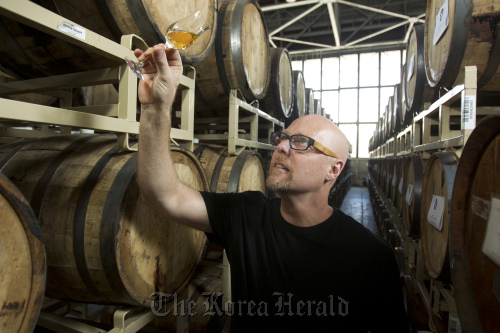Set aside your shot glasses. The next bottle of whiskey you open deserves to be savored.
The Bay Area has become the center of a booming American craft whiskey movement. For years, artisan distillers such as Anchor and St. George Spirits have been dedicated to the craft of small-batch liquid amber. Their innovation is inspiring a new wave of craft distillers, whiskey-themed eateries and events such as October’s WhiskyFest.
The trend comes on the heels of a renewed interest in handcrafted artisanal products, says Bruce Joseph, head distiller at San Francisco’s Anchor Distilling Co., which released its first Old Potrero single malt rye whiskey in 1996.
 |
Lance Winters, owner and distiller of St. George Spirits in Alameda, California, checks the color of his hand-crafted whiskey at the company’s headquarters, April 17. (Contra Costa Times/MCT) |
“People are drinking less, but they’re drinking better,” he says.
In many ways, whiskey tasting is the new wine tasting. When the hip wine lounge District opened its doors in Oakland, Calif., on April 27, it began offering whiskey flights customized by sommelier Caterina Mirabelli.
“Like wine, there are so many flavor profiles in whiskey,” Mirabelli says. “Distillers are making really smooth, more approachable whiskeys that you can sit with and sip for a while.”
At American Oak, a new comfort food restaurant in Alameda, bartending co-owner and whiskey maven Melanie Hartman offers 140 small batch whiskeys from around the world, with an emphasis on American distillers. Hartman arranges whiskey flights by region and runs a whiskey club for regulars called the Personal Liberty League. But this is not a boys club. Half of the members are women.
“We’ve all been doing the craft farmers market cocktail thing for some time now, and whiskey’s popularity came out of that,” Hartman says. “It has big bold flavors. It’s the original American spirit.”
The craft brewing revolution expanded the market for craft distilling nationwide, but what makes Bay Area distillers stand out is their innovation, says Lew Bryson, managing editor of Whisky Advocate.
“What craft whiskey makers in the Bay Area are doing that’s different is applying other models of distilling to their whiskeys,” says Bryson, who writes about beer and whiskey on his blog, Seen Through a Glass. “It’s not about just throwing stuff together and firing it up in the stills anymore.”
Those artisanal models are inspired by cognac, winemaking and eau de vie, or fruit brandy. Whiskey is typically made by the fermentation of grains, distillation and aging in wooden barrels. The types and combination of grains and the length of aging varies by region and distiller.
John Concannon of Concannon Vineyards has a portion of his Ireland-produced malt whiskey aged in old petit sirah barrels before blending, which imparts fruity notes on the finish. The Concannon Irish Whiskey ($25) comes in flint Bordeaux bottles typically reserved for the winery’s cabernet sauvignon.
Concannon introduced the whiskey this past February to honor his Irish great-grandfather, who started the winery in 1883, but also because craft whiskey is a category that’s currently “on fire” among spirits.
“This is not a shot whiskey where everything hits you up front,” he says. “It’s a smooth sipper.”
To make his $325-collector-worthy whiskey, Miles Karakasevic and his son Marko of Charbay Winery & Distillery in St. Helena start with bottle-ready microbrewery pilsner instead of a typical grain mash.
By Jessica Yadegaran
(San Jose Mercury News)
(MCT Information Services)








